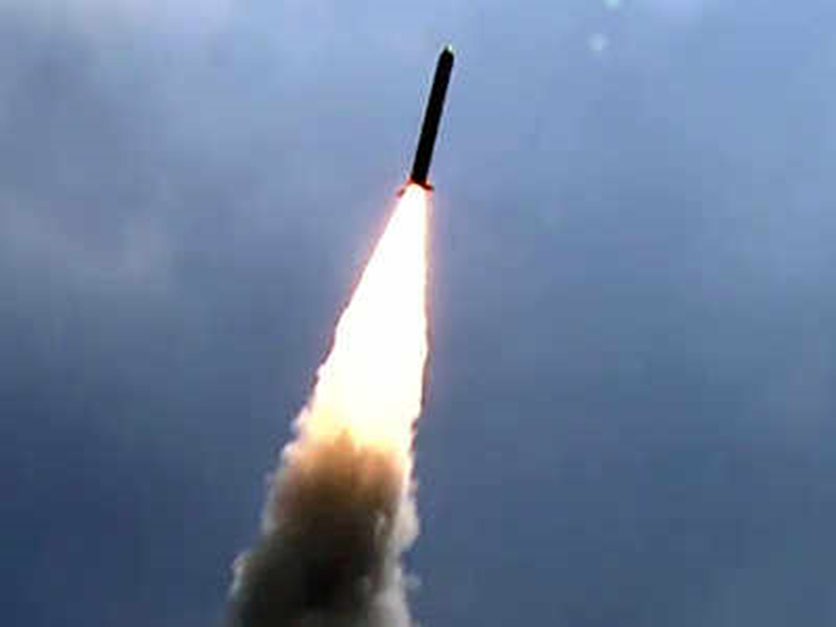India Successfully Tests 1st LR Hypersonic Missile, Joins Select Club to have All 3 Types
India has successfully conducted a flight trial of a long-range hypersonic missile, significantly boosting the country's military readiness. This missile is designed to carry various payloads for ranges greater than 1500 km or 930 miles for the armed forces. This allows India to join a select group of nations possessing all 3 types of long-range hypersonic missiles, besides Russia and China. The missile was tracked by various range systems deployed across multiple domains. Flight data obtained from down-range ship stations confirmed the successful terminal maneuvers and impact with a high degree of accuracy.
Defence Research and Development Organisation (DRDO), conducted the trials of this missile on Saturday night, from the APJ Abdul Kalam Island off the Odisha coast from a mobile articulated launcher, in the presence of senior DRDO scientists and members of the Armed Forces. This missile has been indigenously developed by the laboratories of the Dr APJ Abdul Kalam Missile Complex in Hyderabad, in collaboration with other DRDO laboratories and industry partners. India now has Hypersonic Glide Vehicles (HGVs), Hypersonic Cruise Missiles/Brahmos 2, and Hypersonic Ballistic Missiles in its arsenal. This is reportedly the 2nd test of the missile, with no information available for the result of the 1st test conducted in October 2023.
Why Hypersonic Missiles
Hypersonic missiles are weapons capable of travelling at
speeds above 5 times the speed of sound. The development of hypersonic missiles
is a significant achievement for India, as it presents several challenges,
including managing extreme heat generation, ensuring precise control and
guidance, and avoiding detection and tracking from any kind of effective
interception systems. Hypersonic missiles have the potential to revolutionize
warfare due to their speed, maneuverability, and range. They can significantly
reduce response times for 2nd strike capability and make traditional missile
defense systems less effective.
Their range typically varies between 6,125 km/h (Mach 5) and
about 24,140 km/h (Mach 20). These speeds make them incredibly difficult to
detect and intercept. While Hypersonic Ballistic Missile flies just like any
other ballistic missile but at incredibly high speed in the range of around
Mach 20, the problem is its flight path is largely unguided in its terminal phase
upon re-entry into earth’s atmosphere. Hypersonic Glide Vehicles (HGVs) are
launched like ballistic missiles using a rocket booster. After reaching a
certain altitude, the HGV separates from the booster and glides toward its
target at incredibly high speed in the range of around Mach 20, but its warhead
carrying section or the HGV continuously maneuvers in its terminal flight path
to avoid interception upon re-entry in earth’s atmosphere.
Hypersonic Cruise Missiles on the other hand use scramjet
engines to sustain hypersonic speeds throughout their flight, flying at lower
altitudes and also possessing maneuverability in their entire flight path without
leaving the earth’s atmosphere. The scramjet engines, compress incoming air
before mixing it with fuel to create combustion at supersonic speeds and
push the missile into hypersonic range. Hypersonic missiles are typically
launched using rockets. For hypersonic glide vehicles, the launch rocket boosts/pushes
the missile into a high altitude. Once at the desired altitude, the missile
accelerates to hypersonic speeds.
Unlike traditional ballistic missiles, which are completely
unguided once they are out of the earth’s atmosphere, hypersonic missiles can
maneuver during the entire flight and even during the terminal phase. This makes their
trajectory unpredictable and complicates interception efforts. HGVs use
aerodynamic lift to glide toward their targets, while cruise missiles use their
engines to maintain a sustained speed and direction. The shape of a hypersonic
glide vehicle allows it to maneuver toward a target or away from defenses. The
key is high speed and maneuverability of hypersonic missiles allow them to
strike targets with precision. They can carry conventional or nuclear warheads,
making them versatile for different types of missions.
Combining a glide vehicle with a missile that can launch it partially into orbit - a so-called fractional orbital bombardment system (FOBS) - could strip adversaries of reaction time and traditional defense mechanisms. The global push for hypersonic weapons figures in the efforts of some countries, such as India, which is striving to develop advanced long-range missiles, along with China, Russia, and the USA. The hypersonic missile’s ability to dodge, weave, and outpace SAM defenses leaves current interception technology looking as outdated as an old Morse code machine in the digital age.
Hypersonic Missiles – Strategic Implications
The subcontinent’s rivalry, entrenched in history and geography, now faces a paradigm shift. India’s hypersonic prowess adds a formidable arrow to its quiver, negating Pakistan’s nuclear saber-rattling. With hypersonic missiles that can strike critical assets, including their strategic centers, India now holds a game-changing deterrent. However, this missile can reach anywhere in Pakistan from anywhere in India.
China with its “String of Pearls” strategy and aggressive
posturing in Ladakh is trying hard to suppress India. Beijing is flexing its own hypersonic
missiles and already has all 3 variants of the hypersonic missile variants with
its HGV mounted on the DF 17 missile. India’s successful test is the equivalent of
drawing the line in the Himalayas and saying, “We can play this game too.” But
India will need to increase the range of its LR hypersonic missile from 1500
kms to at least 4500 kms, to stand up and counter China’s growing arsenal.
Strategic Autonomy
India always prides itself on strategic autonomy, a legacy
born from its history of resisting imperial powers for thousands of years. The
hypersonic cruise missile reinforces that independence. Unlike the dependency
on imported equipment during the Kargil conflict, this home-grown marvel
showcases India’s engineering capabilities, free from the strings of foreign
control. Do remember that in any potential conflict, time and speed are of the
essence. Hypersonic missiles can ensure the user has swift pre-emptive strike
capability at its disposal or a punitive second-strike capability, in response
to a devastating first strike. A hypersonic missile takes off from a covert
launch site and can reach its target faster than you can figure out what is
coming your way. By the time an adversary’s command centers detect it, the hypersonic
missile would have already made an impact, silencing key military nodes and
command hubs.
The hypersonic missile isn’t just a one-trick pony. It can be
programmed to hit multiple targets with uncanny speed and precision, a trait
that comes in handy during complex, multi-theatre warfare scenarios. This is
important for India which is staring at a potential two-front war scenario.
The ability to engage and neutralize high-value assets of the enemy or
Pakistan/China, whether on land or at sea, in double quick time and pace they
can’t match, can shift the balance of power dramatically in India’s favor.
Operational Synergy with Existing Arsenal
Pairing hypersonic missiles with India’s existing fleet such as the Mirage 2000s and Sukhoi Su-30 MKIs can enable India to launch coordinated strikes that can overwhelm even the most multi-layered defense of Pakistan and China. Remember India’s hypersonic capabilities don’t stop at the coastlines. Picture a missile system aboard a warship, patrolling the waters of the Indian Ocean, ready to react and strike within seconds. The integration of hypersonic cruise missiles into the Navy’s arsenal ensures that no aircraft carrier or enemy vessel dares venture into India’s maritime backyard unchallenged. Deploying these hypersonic missiles on Indian warships can transform them into floating fortresses capable of enforcing sea denial. They slice through anti-access/area denial (A2/AD) strategies like a hot knife through butter. This turns the tables on adversaries who aim to dominate maritime lanes, ensuring India’s uninterrupted blue-water operations and free passage in vital sea routes.
Deterring Strategic Encroachments
China’s naval ambitions in the Indian Ocean Region (IOR) are
well-documented, with its bases and patrols casting shadows over India’s
influence. Hypersonic deployment ensures that the IOR, from the Strait of
Malacca to the Gulf of Oman, remains under India’s vigilant watch. The message
to any encroacher is clear: The Indian Navy, powered by hypersonic firepower,
is a force to reckon with. Achieving operational mastery over hypersonic
technology isn’t just a cakewalk. It demands overcoming intense heat resistance,
propulsion intricacies, and precision guidance challenges.
While India is forging its path, strategic collaborations
with allies who share democratic values can further accelerate developments.
Joint exercises and technology-sharing agreements enhance not just our
capabilities but also collective security, weaving a tapestry of shared
deterrence. Moving forward, deploying hypersonic missiles across platforms—be
it in silos, air-launch configurations, or aboard submarines—will solidify
India’s defense posture. Integrating these into AI-driven, real-time C4ISR
(Command, Control, Communications, Computers, Intelligence, Surveillance, and
Reconnaissance) systems will ensure seamless coordination and optimal strike
readiness. The hypersonic test is part of India's broader push to develop
advanced defense systems capable of meeting modern warfare challenges. Hypersonic
missiles are seen as the future of missile technology due to their speed,
maneuverability, and ability to evade interception by traditional missile
defense systems. Let's hope India can develop its relevant expertise in
exploiting its capabilities and capacities to the maximum in terms of the use of
hypersonic missiles and counter its adversaries.











India Successfully Tests 1st LR Hypersonic Missile, Joins Select Club to have All 3 Types
ReplyDelete